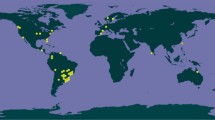Abstract
Routinely grown cell suspension cultures ofMucuna pruriens L. (Fabaceae) were able to endogenously accumulate the anti-Parkinson drug L-dihydroxyphenylalanine (L-dopa) in the range between 0.2 and 2% on a dry weight (DW) basis. The green colour that developed in light-exposed cultures, appeared to be a suitable marker to select cells with an increased L-dopa biosynthesis and/or phenoloxidase activity. For this purpose, saccharose concentrations from 0 to 4% (w/v), and light intensities of 1,000 and 2,000 lux, were involved in the selection procedure. After 6 months, photomixotrophic callus cultures with a rapid growth and a high L-dopa content of 0.9% (DW) were obtained on 2% saccharose and under 1,000 lux. The cell suspensions, derived from these calli, accumulated up to 6% (DW) L-dopa, which was the highest stable content ever measured in cultures ofM. pruriens. An L-dopa yield of approximately 1.2 g/l was calculated after 6 days of growth. In contrast, compared with the standard-grown parent cell line, the phenoloxidase activity, and consequently the bioconversion capacity as measured after entrapment in calcium alginate, of these high-producing cultures was approximately threefold lower.
Similar content being viewed by others
References
Wichers HJ, Pras N, Huizing HJ.Mucuna pruriens: in vitro production of L-DOPA. In: Bajaj YPS. Biotechnology in agriculture and forestry 7. Medicinal and aromatic plants II. Berlin: Springer-Verlag, 1989:349–66.
Huizing HJ, Wichers HJ. Production of L-DOPA byMucuna pruriens cell suspension cultures through accumulation or by biotransformation of L-tyrosine. In: Houwink EH, Van der Meer RR, eds. Innovations in biotechnology. Amsterdam: Elseviers Science Publishers, 1984:217–28.
Wichers HJ, Malingré ThM, Huizing HJ. The effect of some environmental factors on the production of L-DOPA by alginate-entrapped cells ofMucuna pruriens. Planta 1983;158:482–6.
Wichers HJ, Malingré ThM, Huizing HJ. Induction of phenol-oxidase in cell suspension cultures ofMucuna pruriens. Planta 1985;166:421–8.
Pras N, Wichers HJ, Bruins AP, Malingré ThM. Bioconversion of para-substituted monophenolic compounds into corresponding catechols by alginate-entrapped cells ofMucuna pruriens. Plant Cell Tiss Org Cult 1988;13:15–26.
Wichers HJ, Peetsma GJ, Malingré ThM, Huizing HJ. Purification and properties of a phenoloxidase derived from suspension cultures ofMucuna pruriens. Planta 1984;162:334–41.
Pras N, Hesselink PGM, Guikema WM, Malingré ThM. Further kinetic characterization of alginate-entrapped cells ofMucuna pruriens L. Biotechnol Bioeng 1989;34:1461–8.
Yamada Y, Sato F. Measurement of photosynthesis. In: Evans DA, Sharp WR, Ammirato PV, Yamada Y, eds. Hand-book of plant cell culture 1. New York: MacMillan Publishing Co, 1983:489–500.
Mayer AM. Polyphenol oxidases in plants — recent progress. Phytochemistry 1987;26:11–20.
Bell EA. Non-protein amino acids in plants. In: Bell EA, Charlwood BV, eds. Secondary plant products. Berlin: Springer-Verlag, 1980:422–5.
Dalton CC, Peel E. Product formation and plant cell specialization: a case study of photosynthetic development in plant cell cultures. In: Bushell ME, ed. Progress in industrial microbiology. Amsterdam: Elsevier Scientific Publishing Company, 1983:133–5.
Woerdenbag HJ, Lüers JFJ, Van Uden W, Pras N, Malingré ThM, Alfermann AW. Production of the new antimalarial drug artemisinin in shoot cultures ofArtemisia annua L. Plant Cell Tiss Org Cult 1993;32:247–57.
Pras N, Hesselink PGM, Ten Tusscher J, Malingré ThM. Kinetic aspects of the bioconversion of L-tyrosine into L-DOPA by cells ofMucuna pruriens entrapped in different matrices. Biotechnol Bioeng 1989;34:214–22.
Woerdenbag HJ, Pras N, Van Uden W, De Boer A, Batterman S, Visser JF,et al. High peroxidase activity in cell cultures ofArtemisia annua with minute artemisinin contents. Nat Prod Lett 1992;1:121–8.
Van Uden W, Pras N, Batterman S, Visser JF, Malingré ThM. The accumulation and isolation of coniferin from a high-producing cell suspension ofLinum flavum L. Planta 1991;183:25–30.
Fujita Y, Hara Y. The effective production of shikonin by cultures with an increased cell population. Agricult Biol Chem 1985;49:2071–5.
Author information
Authors and Affiliations
Additional information
This publication is dedicated to the memory of Prof. Dr. Th.M. Malingre, who died on 10 April 1993.
Rights and permissions
About this article
Cite this article
Pras, N., Woerdenbag, H.J., Batterman, S. et al. Mucuna pruriens: Improvement of the biotechnological production of the anti-Parkinson drug L-dopa by plant cell selection. Pharm World Sci 15, 263–268 (1993). https://doi.org/10.1007/BF01871128
Accepted:
Issue Date:
DOI: https://doi.org/10.1007/BF01871128




